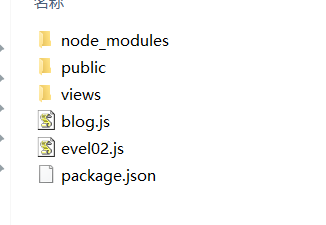最近在学习vue的一个实战项目,碰到一个express,当时很萌,就随便看了看................
expres是基于node 的一个web框架,
首先可以找到它的官网照着学习
这里只讲一些官网上没有的或者很晦涩的东西.........
1)模版引擎的使用
给出package.json的依赖
{
"name": "demo",
"version": "1.0.0",
"description": "",
"main": "demo01.js",
"scripts": {
"test": "echo "Error: no test specified" && exit 1"
},
"author": "",
"license": "ISC",
"dependencies": {
"body-parser": "^1.18.2",
"express": "^4.16.2",
"hbs": "~2.3.1",
"jade": "^1.11.0"
}
}
你可以npm install 一下,
我这里要坐的就是使用express的路由兼模版引擎搭建一个小网站。
2)首先你的建立几个文件夹

node_modules:这个就不解释了,你稍微使用个就知道了。
public:这个里面我们主要是放些css,images等文件
views:是视图文件(主要放一些)
blog.js:主要是数据(模拟数据)
evel02.js:就是我的启动文件(大家习惯的是app.js)
3)边看代码,遍解释
evel02.js
var express= require('express'); //http://www.jb51.net/article/58166.htm var bodyParser = require('body-parser'); var path = require('path'); var app = express(); // hbs是express的众多模版之一,可以google一下去了解。
//可以去了解:https://www.cnblogs.com/chyingp/p/hbs-getting-started.html
var hbs = require('hbs'); //设置模版引擎 app.set("view engine",'html'); app.engine("html",hbs.__express); //加载数据 var blogEngine = require('./blog'); //app.use(bodyParser()); // parse application/x-www-form-urlencoded app.use(bodyParser.urlencoded({ extended: false })); // parse application/json app.use(bodyParser.json()) ; app.get('/',function(req,res){ // res.render('index'); res.render('index', { tile:'最近的文章', entries:blogEngine.getBlogEntries() }); }); app.get('/about',function(req,res){ //res.render('about');
//渲染页面 res.render('about',{title:"自我介绍"}); }); app.get('/article/:id',function(req,res){ //res.render('article'); var entry = blogEngine.getBlogEntry(req.params.id); res.render("article",{title:entry.title,blog:entry}); }); //制定静态文件目录 //app.use(express.static('public')); app.use(express.static(path.join(__dirname, 'public'))); //监听3000端口 app.listen(3000);
blog.js
var entries =[ {"id":1,"title":"第一篇","body":"正文1","published":'4-1-2017'}, {"id":2,"title":"第二篇","body":"正文2","published":'4-2-2017'}, {"id":3,"title":"第三篇","body":"正文3","published":'4-3-2017'}, {"id":4,"title":"第四篇","body":"正文4","published":'4-4-2017'}, {"id":5,"title":"第五篇","body":"正文5","published":'4-5-2017'}, {"id":6,"title":"第六篇","body":"正文6","published":'4-6-2017'}, {"id":7,"title":"第七篇","body":"正文7","published":'4-7-2017'}, ]; //倒出两个方法 exports.getBlogEntries = function(){ return entries; }; exports.getBlogEntry = function(id){ for(var i =0;i<entries.length;i++){ if(entries[i].id == id) return entries[i]; } };
views(是express的默认视图文件夹)

layout.html
<html>
<head>
<title>{{title}}</title>
</head>
<body>
{{{body}}}
<footer>
<p>
<a href="/">首页</a> - <a href="/about">自我介绍</a>
</p>
</footer>
</body>
</html>
index.html
<h1>文章列表</h1> {{#each entries}} <p> <a href="/article/{{id}}">{{title}}</a><br/> Published: {{published}} </p> {{/each}}
article.html
<!-- <!DOCTYPE html>
<!DOCTYPE html>
<html>
<head>
<meta charset="utf-8">
<title></title>
</head>
<body>
<p>34333</p>
{{blog.title}}
</body>
</html> -->
<h1>{{blog.title}}</h1>
Published: {{blog.published}}
<p/>
{{blog.body}}
about.html
<!-- <h1>自我介绍</h1> {{title}} <p>正文</p> <img class="img" src="/images/q.jpg" alt=""> --> <!DOCTYPE html> <html> <head> <meta charset="utf-8"> <title>{{title}}</title> <link rel="stylesheet" href="/css/style.css"> </head> <body> <div class=""> <h1>自我介绍</h1> <div class=""> <img class="img" src="/images/q.jpg" alt=""> </div> </div> <h3>w文件上传递</h3> <div class=""> <form action="/pictures/upload" method="POST" enctype="multipart/form-data"> Select an image to upload: <input type="file" name="image"> <input type="submit" value="Upload Image"> </form> </div> </body> </html>
这里要解释一下,我的about.html模版是使用的html页面,当然你也可以使用hbs的模版
<h1>自我介绍</h1> {{title}} <p>正文</p> <img class="img" src="/images/q.jpg" alt="">
完整学习实例参考:http://blog.csdn.net/ganxunzou/article/details/42918015
(知识共享,知识的搬运工)
看完这片文章就在思考怎么将express与前端相结合起来呢???(我不轻易问问提的。。。。)
写个css的都知道前端框架有很多vue,angular,react,他们都有自己的路由机制,而且还是蛮好用的。。。。。
探究一番。。。。
文件目录:

app.js
(这个是没有使用express的模版引擎的,我要做的就是使用express做接口数据层,使用前端路由,访问接口地址,进行数据获取)
var express = require("express"); var path =require("path"); var routes = require("./routes/index");// var app = express(); app.use(express.static(path.join(__dirname,'public'))); app.use('/',routes); app.listen(3001);
routes/index.js
var express = require('express'); var router = express.Router(); router.get('/',function(req,res,next){ res.render('index',{ title:'express' }); }); router.get('/foo',function(req,res,next){ res.json({ "name":"tom", "age":33 }) }); router.get('/bar',function(req,res,next){ res.send({ "name":"bar", "age":33 }) }); router.get('/goinfo',function(req,res,next){ res.send({ "name":"goinfo", "age":33 }) }); module.exports =router;
看到这里可能有同学说这个和上面那个例子不是一样的吗????
不一样。。。区别就是res.send(),与res.render()的区别,并且我也没用express的模板引擎
res.send(),或者res.json()是还回数据,res.render()渲染页面
public:(主要存放一些资源文件)

index.html
(使用vue框架,简单的搭建了几个页面,没有使用vue-cli,因为不是终点)
<!DOCTYPE html>
<html>
<head>
<meta charset="utf-8">
<title></title>
<script type="text/javascript">
</script>
<script type="text/javascript" src="../lib/vue2.js"> </script>
<script type="text/javascript" src="../lib/vue_router.js"> </script>
<script type="text/javascript" src="../lib/axios.min.js"> </script>
</head>
<body>
<div class="">
</div>
<div class="" id="app">
</div>
</body>
</html>
<script type="text/javascript">
const Home={
template:'<div>this is home page</div>',
// methods:{
// getData(){
// axios.get('/').then(function(res){
// console.log(res);
// }).catch(function(err){
// console.log(err);
// });
// }
// },
// mounted(){
// this.getData();
// }
};
const foo={
template:'<div>this is foo page</div>',
methods:{
getData(){
axios.get('/foo').then(function(res){
console.log(res);
}).catch(function(err){
console.log(err);
});
}
},
mounted(){
this.getData();
}
};
const bar={
template:'<div>this is bar page</div>',
methods:{
getData(){
axios.get('/bar').then(function(res){
console.log(res);
}).catch(function(err){
console.log(err);
});
}
},
mounted(){
this.getData();
}
};
const goInfo={
template:'<div>this is foo goInfo</div>',
methods:{
getData(){
axios.get('/goInfo').then(function(res){
console.log(res);
}).catch(function(err){
console.log(err);
});
}
},
mounted(){
this.getData();
}
};
const router =new VueRouter({
mode:'history',
routes:
[
{
path:'/',
name:'home',
component:Home,
// children:[
// {path:'foo',name:'foo',component:foo},
// ]
},
{path:'foo',name:'foo',component:foo},
{path:'/bar',name:'bar',component:bar},
{path:'/goinfo',name:'goinfo',component:goInfo},
]
})
const mou = new Vue({
el:"#app",
router,
template:`
<div id="app">
<h1>Name Routes</h1>
<p>currnt route </p>
<ul>
<li>
<router-link :to="{name:'home'}">home</router-link>
</li>
<li>
<router-link :to="{name:'foo'}">foo</router-link>
</li>
<li>
<router-link :to="{name:'bar'}">bar</router-link>
</li>
<li>
<router-link :to="{name:'goinfo'}">goinfo</router-link>
</li>
</ul>
<router-view></router-view>
</div>
`
});
</script>
然后你直接在命令行输入: node app.js
访问localhost:3000
主要的已经讲完了,
接下来补充几点:
//若要设置HTTP头部信息 app.get('/htp',function(req,res){ var body = "Hello world"; res.setHeader("Content-Type","text/plain"); res.setHeader('Content-Length',body.length); res.setHeader('expire',"nocache"); res.send(body); });
参考例子:http://www.cnblogs.com/KevinSong/p/4495729.html#3837987
例子源码地址:
https://github.com/EvalGitHub/myExpress